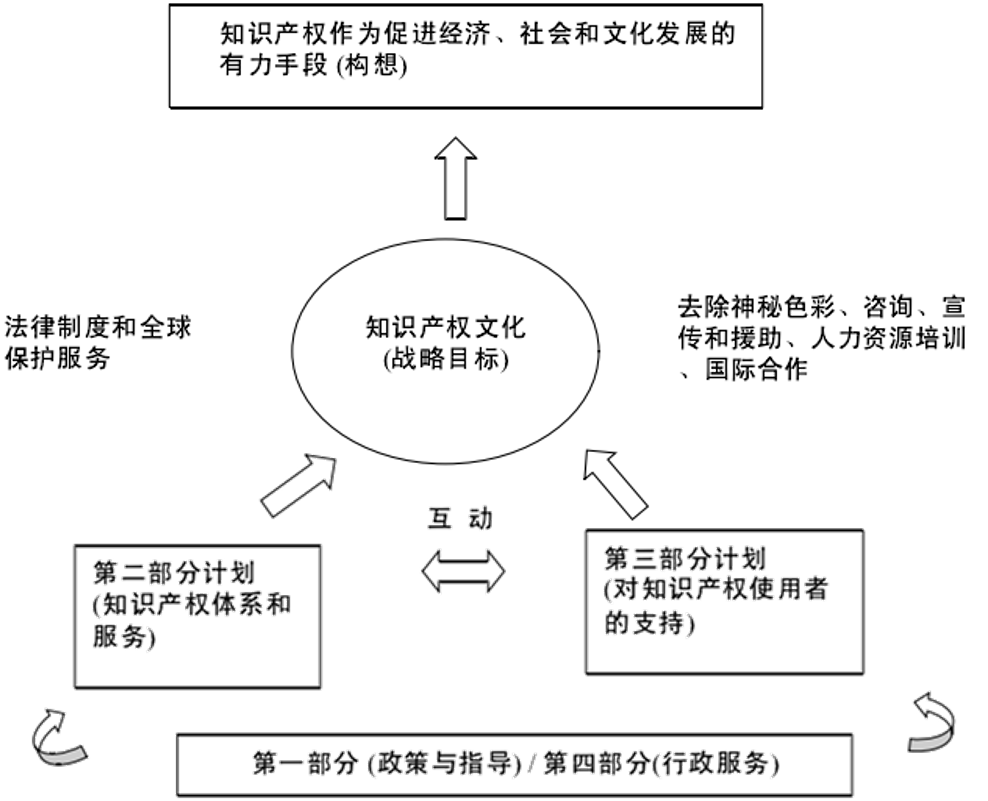知识产权文化的构想源头:世界知识产权组织(WIPO)
- 发布时间:2015-10-11
- 发布者:武汉知识产权研究会
一、知识产权文化的首次提出:《经修订的2004~2005年计划和预算草案》
世界知识产权组织(WIPO)在其2003年9月召开的计划和预算委员会第七届会议上正式提出了“知识产权促进发展与繁荣,建立知识产权文化”的创意,会议正式通过的《经修订的2004~2005年计划和预算草案》确定了“共同需要:建立一种明达的知识产权文化”构想:“为了迎击这些挑战,WIPO在2004-2005年期间将着重支持建立一种知识产权文化。建立一种充满活力的知识产权文化,可以让所有利益有关者在一个相互联系的战略整体中发挥各自的作用,并能实现知识产权作为促进经济、社会和文化发展有力手段的潜力。要建立这种充满活力的知识产权文化,就要以保证知识产权制度有效而且能兼顾各方利益为基础,并要求这一制度的使用者积极活跃、完全知情、多元化而且在开始使用时受到的阻碍较小,这样才能让范围更广的各界人士均能明智而成功地利用知识产权。WIPO将充分利用去除神秘色彩的运动所取得的成就及其为进一步开展工作所奠定的良好基础,为成员国努力发展知识产权制度和促进对知识产权的战略性使用提供的更大支助。标志这一方面所取得的进展的一个主要指标将是,大量经济体均已积累并能有效利用本国的知识产权资产。这样便会逐渐有助于进行更多的生产投资、合作研究与开发、技术交流、国家品牌的创建和传统产业的提升,使传统产业成为全球市场中的突出企业,从而创造更多的就业机会,维护和加强文化多样性及人力知识资本:简言之,在全球化经济当中,减少贫困,实现更加公平的繁荣,同时加强各种互不相同的地方特色,有效地评价经济和文化多样性的价值。”
英文原文:
The Shared Need: Developing an Informed IP Culture
5. To meet these challenges, WIPO will emphasize and support the development of an IP culture during 2004-2005. A dynamic IP culture enables all stakeholders to play their distinct roles within a coherent, strategic whole, and to realize the potential of IP as a power tool for economic, social and cultural development. A dynamic IP culture is founded on the maintenance of an effective, balanced IP system, but also requires active, well-informed and diverse users of the system, assisted by lower entry barriers, thus allowing for the astute and successful use of Intellectual Property Rights (IPRs) by a much wider range of constituencies. WIPO will leverage the achievements of the demystification campaign, which has already provided a sound basis for further work, and will also enhance its support for Member States’ efforts in developing IP systems and promoting the strategic use of IP rights. The chief evidence of progress in this direction will be the accumulation and effective exploitation of national IP assets by a wide range of economies. This should progressively foster more productive investment, cooperative research and development, technology exchange, national brand-making, and leverage of traditional industries into distinctive enterprises in the global market, leading in turn to job creation and the retention and enhancement of cultural diversity and intellectual human capital: in short, poverty reduction and more equitable prosperity in a globalizing economy, while reinforcing distinctive local characteristics and effectively valuing economic and cultural diversity. [[1]]
“7.为了确保WIPO的活动有效集中于创建知识产权文化,已重新调整了几项计划的重点。主体计划11(知识产权促进发展与繁荣;建立知识产权文化)将协调和传播向那些希望利用知识产权这一有力手段促进经济和商业发展的决策者和企业家所提供的专家咨询意见和背景知识。WIPO的构想和战略中承认,集体领导对创建知识产权文化具有十分重要的意义。为了落实这一远见,分项计划11.3(与私营部门的合作)将促成与私营和非政府部门以及政府部门之间达成合作伙伴协议。知识产权战略管理方面的许多实际的专门知识以及利用知识产权制度获得实际利益的技能,均掌握在私营部门手中,而这一技术诀窍和实际经验对实现知识产权的潜力具有不可估量的价值。知识经济是受新的科学技术进步驱动的:信息与通信技术以及生命科学的发展,由于其具有增强技术的能力并具有改变许多技术、工业和社会格局的潜力,而尤其受到重视。这些技术也对现有的知识产权制度提出了前所未有的挑战。WIPO对这些挑战的对策将通过两项新的分项计划来协调:版权产业与文化的发展(分项计划5.2)以及知识产权与生命科学 (分项计划7.2)。”
英文原文:
7. Several programs have been refocused to ensure that WIPO’s activities concentrate effectively on the creation of an IP culture. Main Program 11, Intellectual Property for Development and Prosperity; Creation of IP Culture, will coordinate and disseminate expert advice and background information for policy-makers and entrepreneurs seeking to use IP as a power tool for economic and WO/PBC/7/2 page 6 commercial development. The vision and strategy of WIPO recognize that collective leadership is essential for the creation of an IP culture. To give practical effect to this insight, sub-program 11.3, Cooperation with the Private Sector, will catalyze partnering arrangements between the private and non-government sectors and the government sector. Much of the practical expertise in the strategic management of IPRs, and skilled capacity to use the IP system to yield tangible benefits, resides in the private sector, and this know-how and practical experience is invaluable for the realization of potential of IPRs. The knowledge economy has been driven by new technologies and scientific advances: developments in information and communications technology and in life sciences have drawn particular scrutiny because of their capacity as enabling technologies and their potential to transform a wide range of technological, industrial and social patterns. These technologies also pose unprecedented challenges for the existing IP system. WIPO’s responses to these challenges will be coordinated through two new sub-programs: Copyright-based Business and Culture Development (sub-program 5.2) and Intellectual Property and Life Sciences (sub-program 7.2). [[2]]
根据《经修订的2004-2005年计划和预算草案》,WIPO 重新调整丁各项计划活动并更加重视执行计划中的协凋工作。其具体工作汁划分为四大部分: 第一部分( 政策与指导) 涉及整个计划和预算的总方向;第二部分( 知识产权各体系和问题) 旨在发展各知识产权体系,争取在关键的知识产权问题上达成国际协商一致,井加强WIPO 通过其全球保护体系向市场和研究部门的使用者所提供的服务;第三部分(知识产权促进经济、社会和文化发展)旨在提高知识产权制度中各不同利益有关者的实际认识,并建立和采用其所需要的手段;第四部分( 行政服务)为WIPO 的其他计划领域及资源管理提供行政支助,让本组织能经常做出调整以确保各项服务的高质量,并能应对完成计划时所遇到的快速变化和满足日益复杂的需求。图1展示了WIPO 在知识产权文化方面的具体工作思路。

图1 WIPO的构想、战略和计划之间的关系概览
Source:REVISED PROPOSAL FOR PROGRAM AND BUDGET 2004-2005,Page7.
总干事卡米尔·伊德里斯也在《世界知识产权组织计划活动的中期计划——世界知识产权组织构想与战略方向》中进一步明确了把创建知识产权文化作为目前至2009年期间WIPO构想与战略方向中一项重点工作,其思路是促进和鼓励每个国家发展一种适合其需要的知识产权文化,包括各有侧重的国家知识产权战略、最适宜的国家知识产权制度,并在全国范围内(既在政策规划层也在基层)提高对知识产权作为促进经济、社会和文化发展的强有力手段的认识。
二、知识产权文化的延续:《 2006-2007年计划和预算草案》
在2005年4月27日-29日召开的计划和预算委员会第八届会议中通过的《拟议的2006 一2007 年计划和预算》 中,WIPO进一步延续了促进知识产权文化繁荣发展的思路。在其确定的五项战略目标中,促进知识产权文化被排在第一位:
“9.鉴于上述挑战,并根据W IPO 2006 - 2009年的中期目标、构想和战略方向(‘中期计划’,见文件‘A/39/5’),拟议的2006/07两年期计划和预算在编制上做到了清楚地说明成员国在中期计划中所批准的本组织的中期目标与2006/07两年期拟议活动之间的关系。共有以下5项战略目标:1.通过与各国政府、政府间组织、私营部门合作伙伴及其他有关社区开展合作,为在各成员国建立更加坚实、广泛的知识产权文化奠定基础。”[[3]]
英文原文:
9. With the above challenges in mind, and consistent with the medium-term objectives, vision and strategic direction of WIPO for 2006-2009 (“the medium-term plan,” see document A/39/5), the proposed Program and Budget for the biennium 2006/07 has been formulated in such a way as to clearly show the relationship between the Organization’s medium-term goals, as approved by Member States in the medium-term plan, and the proposed activities for the 2006/07 biennium. The five strategic goals are as follows: building the foundation for a more solid and extensive IP culture in Member States through cooperation with governments, intergovernmental organizations, partners in the private sector and other interested communities.[[4]]
在《拟议的2006 一2007 年计划和预算》 第五部分“按战略目标分类的拟议计划”中拟定了“促进知识产权文化”的详细计划,主要任务包括:[[5]]
联系公众与交流(Public Outreach and Communication)。促进世界媒体对WIPO和知识产权问题的注意;加深决策者和公众对知识权的作用和WIPO及其活动的理解;促进对WIPO国际登记服务的认识;侧重知识产权和有关的全球问题的丰富的图书馆馆藏;加强WIPO的内部联系和整个知识产权界的联系;
对外协调(External Coordination)。查明与其他国际组织,包括联合国各机构、基金会和计划署、世界银行、世贸组织和国际植物新品种保护联盟在知识产权问题上的新的合作和协调机会;加强在联合国全系统问题上的机构间合作和协调,推进联合国系统的宗旨和目标;
战略性利用知识产权促进发展(Strategic Use of IP for Development)。加强有关知识产权保护对经济发展影响的有案可查的证据,决策者深入理解知识产权使用与发展战略之间的关系;加强有关知识产权对发展影响的研究成果的国际交流;加强与公私各方利益攸关者的伙伴关系,更充分地显示知识产权保护与经济发展之间的关系;增强中小企业和中小企业支助机构使用知识产权制度工具的意识和能力;增进中小企业支助机构向其客户提供服务的能力;增强成员国,尤其是工商界和研究机构开发和管理知识产权资产的能力;对从财政上支持成员国工商界和研究机构开发知识产权资产有更清醒的认识,并提供这方面的信息;
数字环境中版权的使用(Use of Copyright in the Digital Environment)。加强对数字环境中版权的商业利用可能性的切实理解;加深认识版权对缩小数字鸿沟的贡献;加深理解新兴技术对版权内容的创造、获得和使用的影响;
知识产权与公共政策(IP and Public Policy)。加深决策者和广大公众对知识产权与公共政策之间关系的理解。
[[1]] WIPO,Program and Budget Committee: Seventh Session. REVISED PROPOSAL FOR PROGRAM AND BUDGET 2004-2005, INTRODUCTION [DB/OL]. http://www.wipo.int/meetings/en/details.jsp?meeting_id=4914. 2015-10-11.
[[2]] WIPO,Program and Budget Committee: Seventh Session. REVISED PROPOSAL FOR PROGRAM AND BUDGET 2004-2005, INTRODUCTION [DB/OL]. http://www.wipo.int/meetings/en/details.jsp?meeting_id=4914. 2015-10-11.
[[3]]世界知识产权组织. 拟议的2006 -2007 年计划和预算, 第一部分:总干事的概要[DB/OL]. 资料来源:世界知识产权组织网,网址:http://www.wipo.int/meetings/en/doc_details.jsp?doc_id=39812. 文件下载地址:http://www.wipo.int/edocs/mdocs/govbody/zh/wo_pbc_8/wo_pbc_8_3-toc1.pdf. 访问时间:2015-10-11.
[[4]] WIPO,Program and Budget Committee: Eight Session. PROPOSED PROPOSAL FOR PROGRAM AND BUDGET 2006/2007, PART I: DIRECTOR GENERAL’S HIGHLIGHTS [DB/OL]. Page2. http://www.wipo.int/edocs/mdocs/govbody/en/wo_pbc_8/wo_pbc_8_3.pdf. 2015-10-11.
[[5]] See WIPO,Program and Budget Committee: Eight Session. PROPOSED PROPOSAL FOR PROGRAM AND BUDGET 2006/2007, PART I: DIRECTOR GENERAL’S HIGHLIGHTS [DB/OL]. Page25-38. http://www.wipo.int/edocs/mdocs/govbody/en/wo_pbc_8/wo_pbc_8_3.pdf. 2015-10-11.


